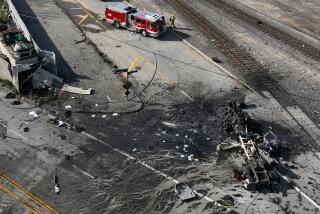Deaths of 3 Men, Source of Gas Tanks Investigated : Chatsworth: Two 80-pound tanks of nitrous oxide were taken Feb. 19 from Holy Cross Medical Center, where one of the victims worked until October.
Los Angeles police said Monday that they are investigating whether two tanks of nitrous oxide--so-called laughing gas--linked to the accidental deaths of three young men were stolen from a hospital where one of the victims formerly worked.
On Friday, three men were found dead of apparent asphyxiation in the cab of a pickup truck parked in Chatsworth. There was an 80-pound cylinder of nitrous oxide in the truck’s bed and another with the victims in the cab, where it was still emitting gas from a partially open valve when police found the bodies.
Police and Holy Cross Medical Center officials said that three weeks ago someone with a key stole two gas cylinders identical to those found in the pickup from a locked and walled storage area at the Mission Hills hospital.
One of the victims, Michael Cook, 23, of Sherman Oaks, had been employed at the hospital as a maintenance worker until October and had access to a key to the storage area, Holy Cross spokeswoman Maggie Cessar said.
Cessar would not reveal the circumstances of Cook’s leaving the job, citing an employee confidentiality policy.
However, determining whether the cylinders in the pickup were those taken from Holy Cross was complicated Monday because the tanks do not have traceable serial numbers. Instead, they carry lot numbers that indicated that they were among 30 delivered by Liquid Air Corp. to four different hospitals. Police have asked the hospitals to inventory their tanks.
“We will get it narrowed down,” Detective Mitch Robins said. “Right now, the best guess is that they came from Holy Cross.”
Police said the three deaths and a spate of thefts have spurred hospitals to better secure the tanks. At least six cylinders of the gas have been stolen this year from Holy Cross and Northridge Hospital Medical Center.
In addition to the two stolen Feb. 19 from Holy Cross, two were taken from the hospital’s storage area Friday night, after the three men died. Two were taken in January from Northridge.
“We are enclosing the whole area where ours are kept and re-keying the locks,” Cessar said.
A Northridge spokeswoman said hospital security personnel have begun a daily, and sometimes twice-daily, inventory of the tanks stored there.
Nitrous oxide is a mild anesthetic used during medical procedures. State law prohibits its recreational use. But, like glue, which is illegal to inhale, the gas is widely available for legitimate purposes. Nitrous oxide is also commonly used in food preparation and as a fuel additive for high-performance vehicles.
The gas has become increasingly popular among young people who take part in “underground raves,” or parties, in the Los Angeles area.
The three victims, who were found by passing police officers at 4 a.m. Friday in the truck on Topanga Canyon Boulevard, had apparently spent the evening before at a rave party at a West Hollywood nightclub.
Those familiar with raves say balloons full of nitrous oxide sell from $3 to $5 each in the parking lots outside--and sometimes inside--such parties. Some party regulars said nitrous oxide dealers can make several thousand dollars from the gas contained in a single cylinder the size of those the victims had.
Police and friends of the victims said it was unclear what the three men planned to do with the two cylinders. Some familiar with the rave scene speculated that they may have planned to sell balloons of laughing gas outside a large rave scheduled Saturday. Flyers advertising the party were found inside the pickup truck.
But friends denied that the three had ever been involved in selling the gas.
In addition to Cook, the victims were identified as Matthew Champy, 21, of Woodland Hills and Richard Dellavechia, 20, of North Hills.
An official ruling on their cause of death is pending the completion of laboratory tests following their autopsies, a coroner’s spokesman said Monday.
More to Read
Sign up for Essential California
The most important California stories and recommendations in your inbox every morning.
You may occasionally receive promotional content from the Los Angeles Times.









